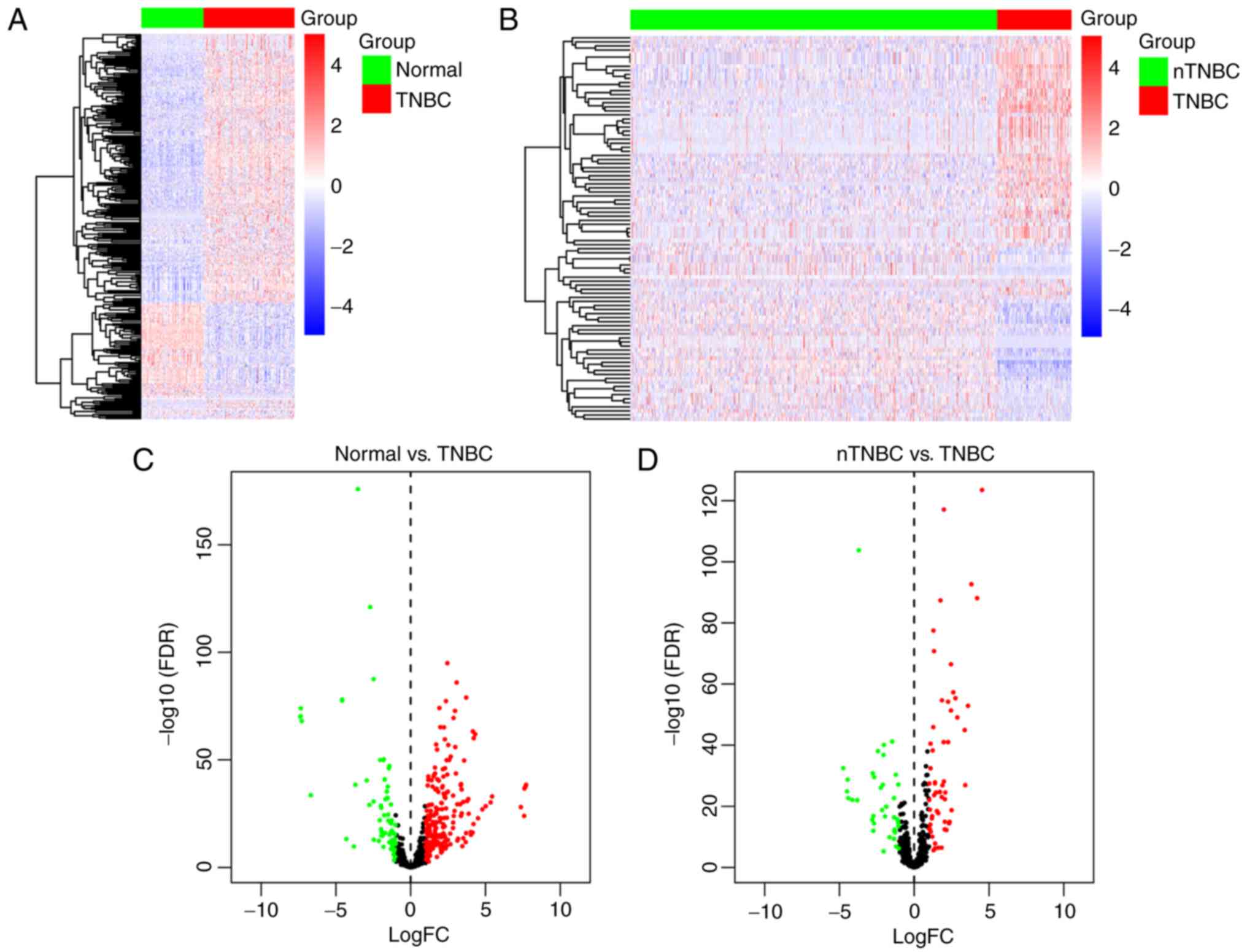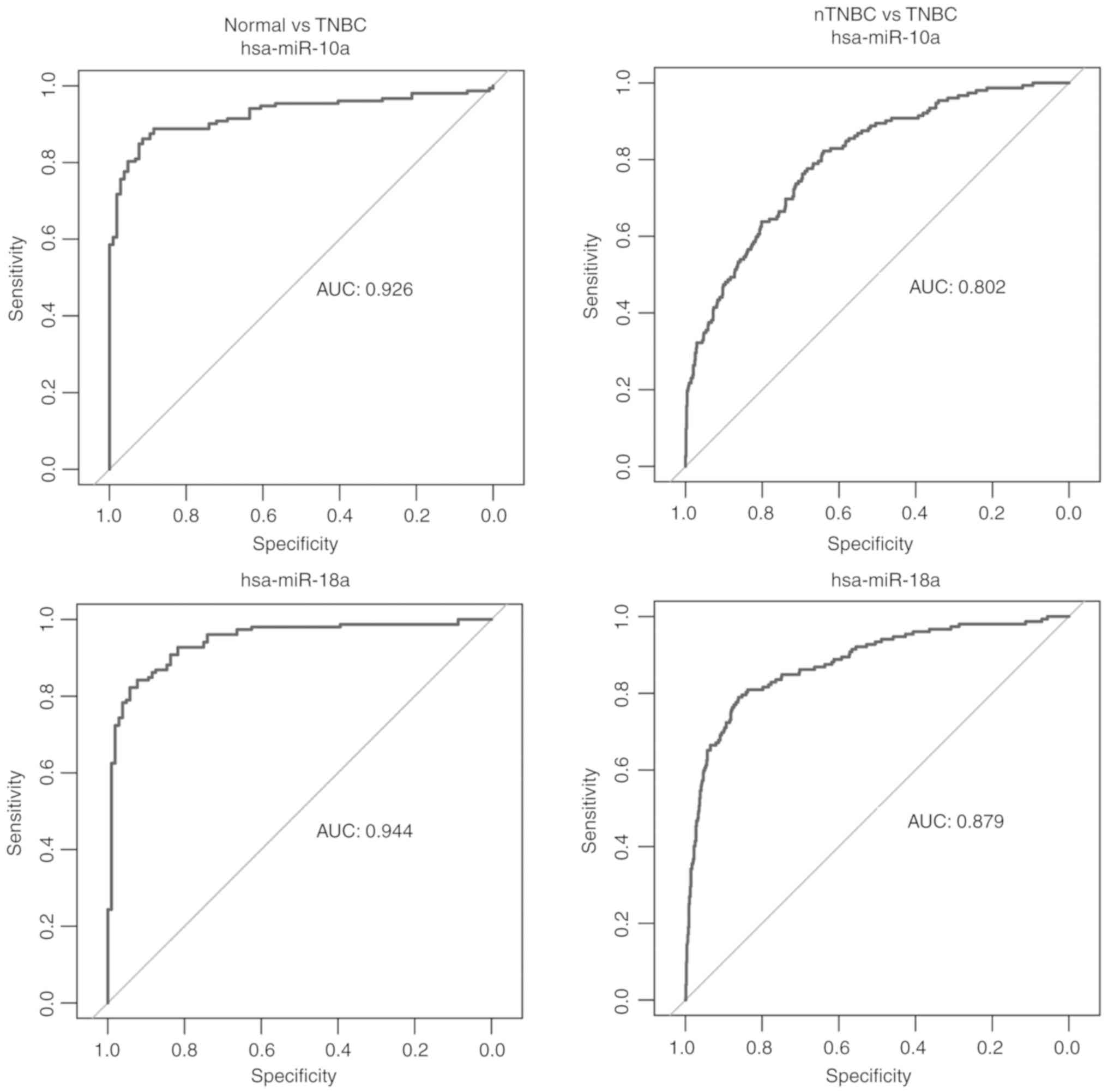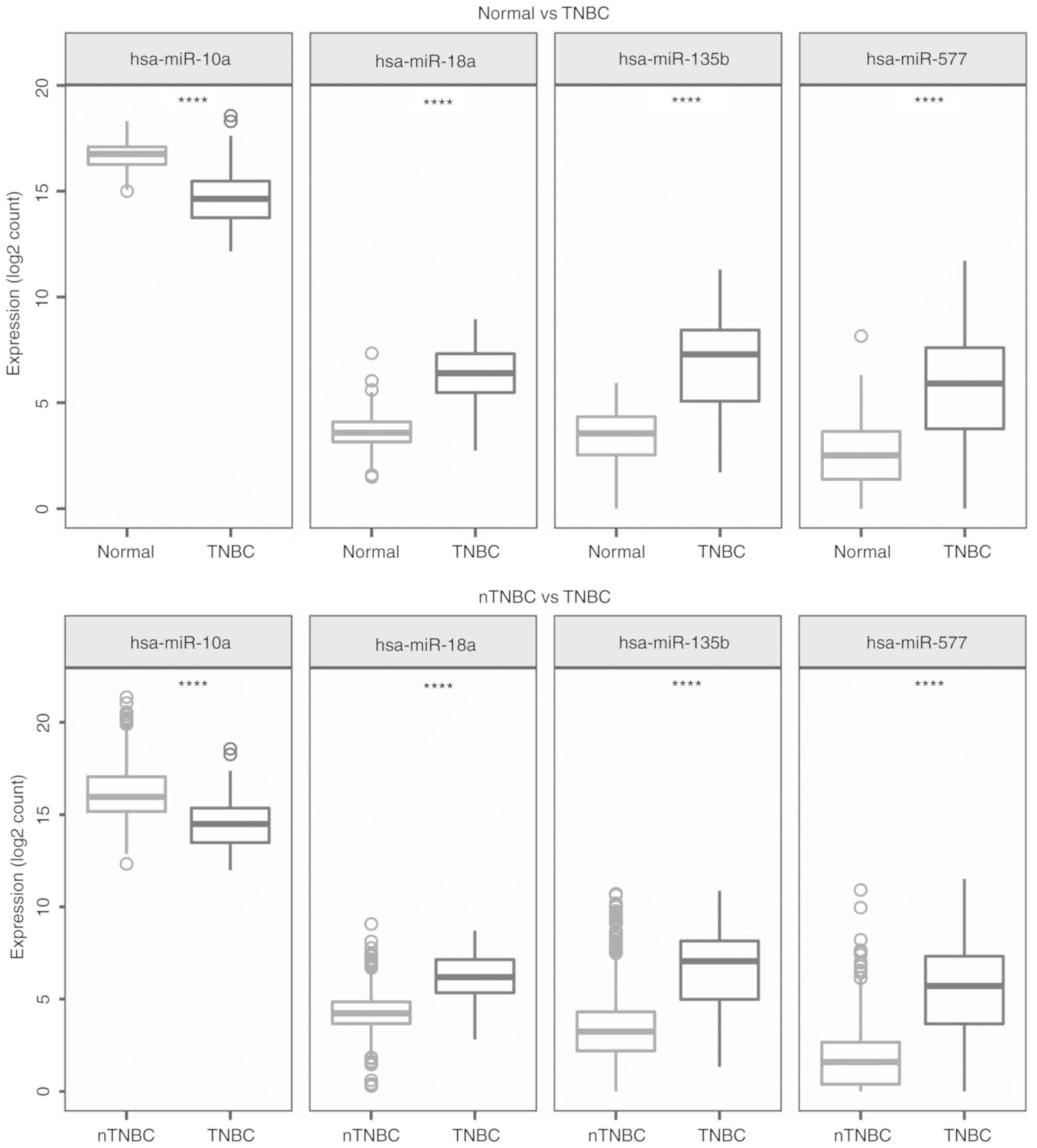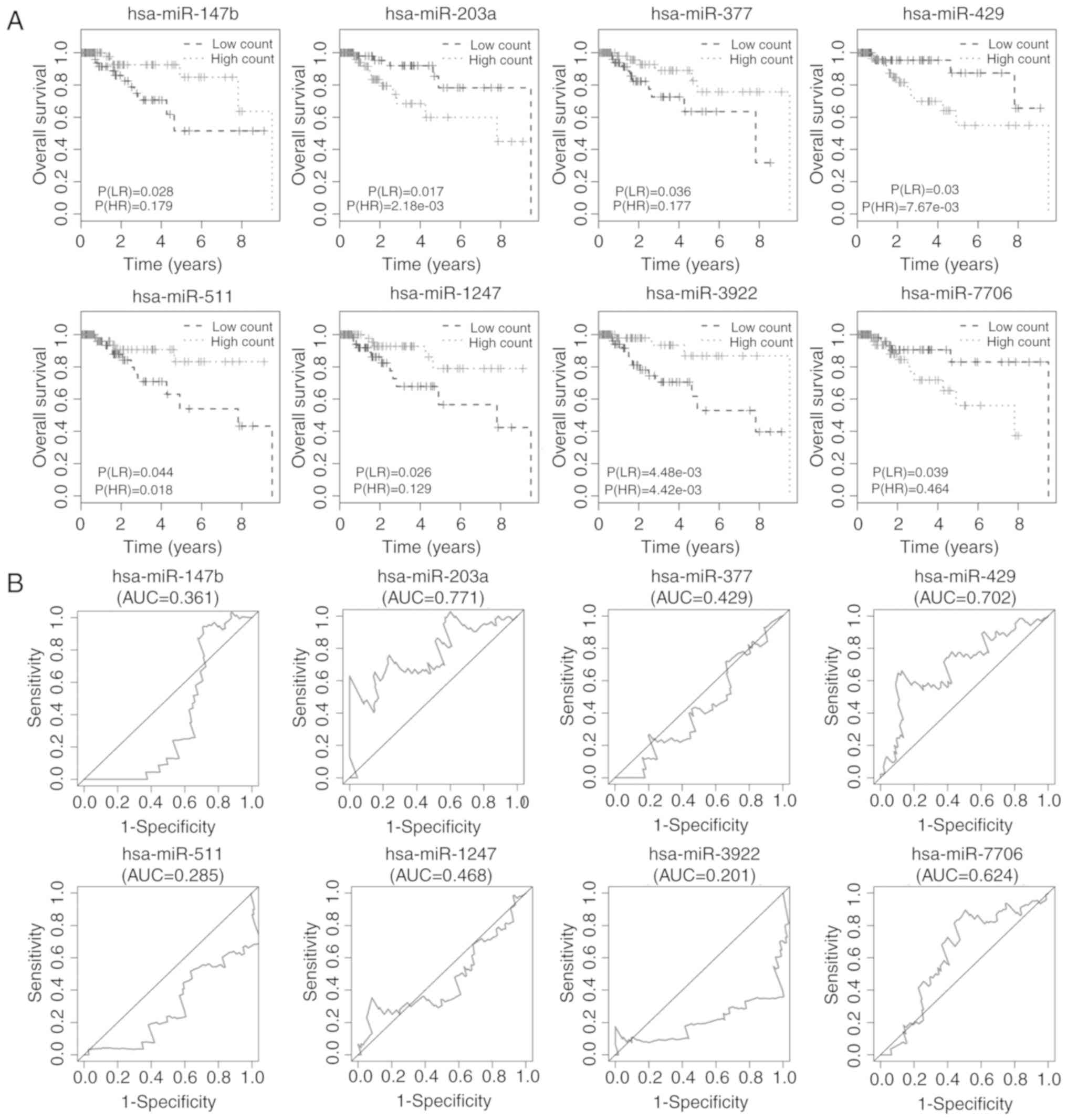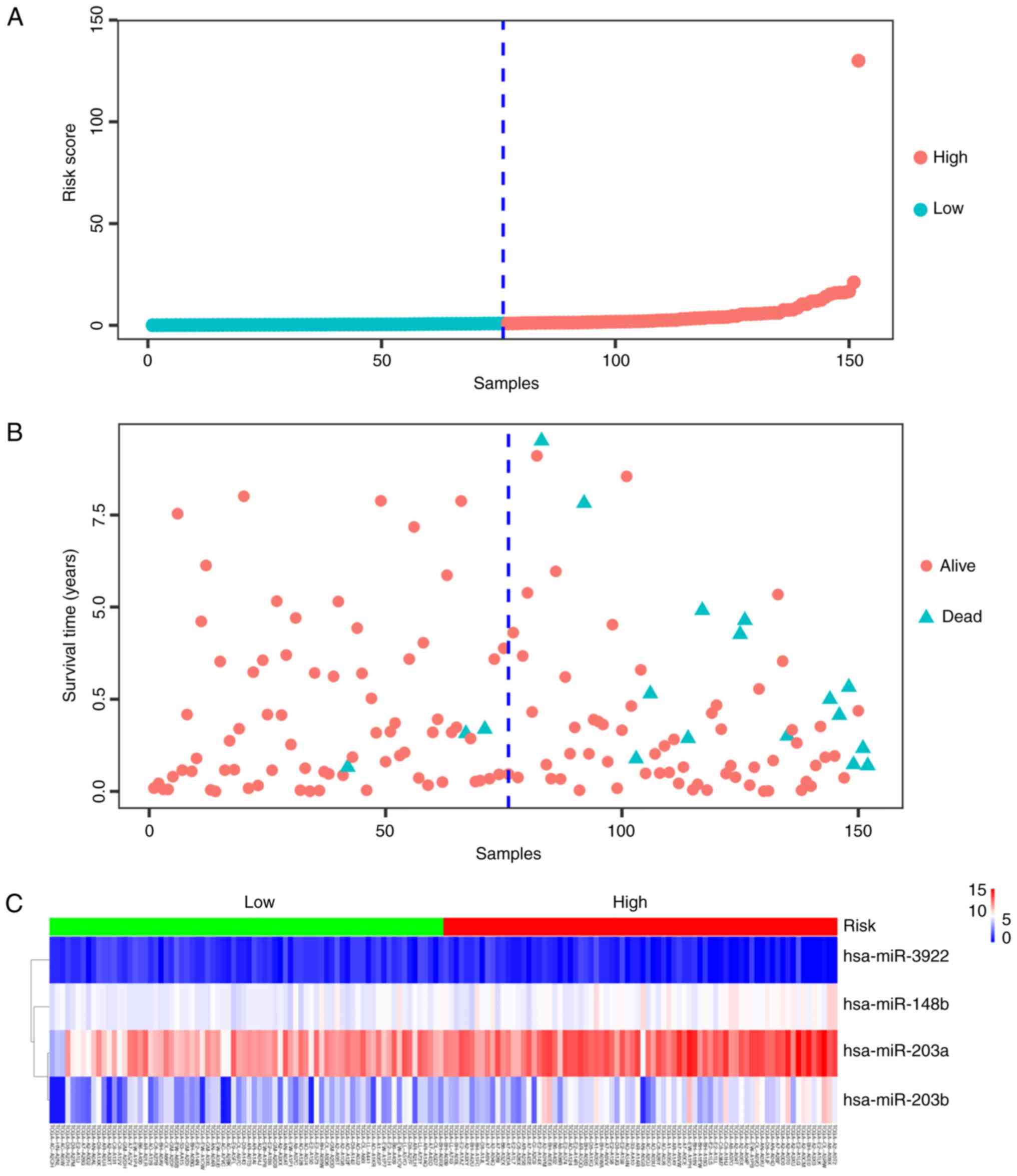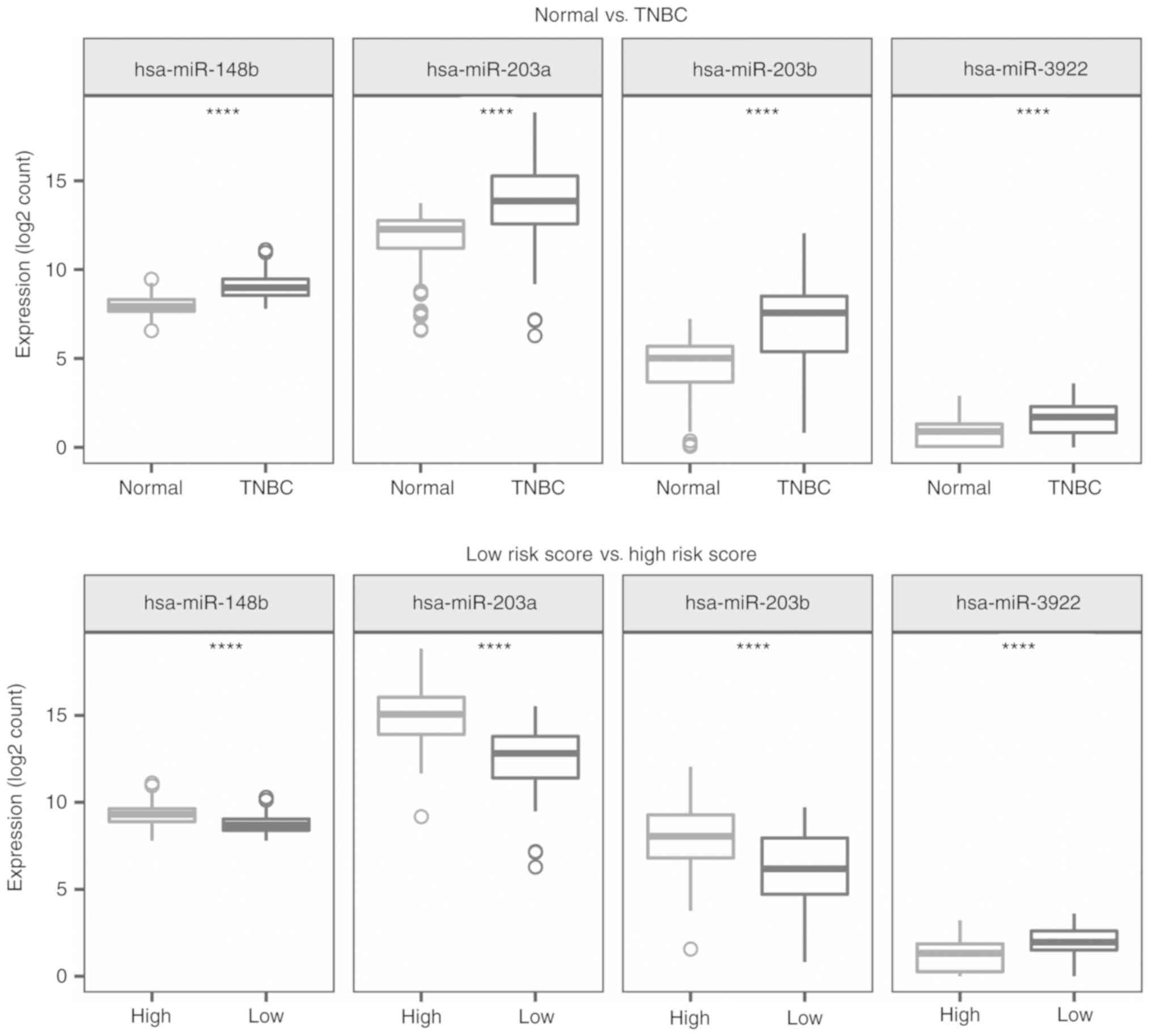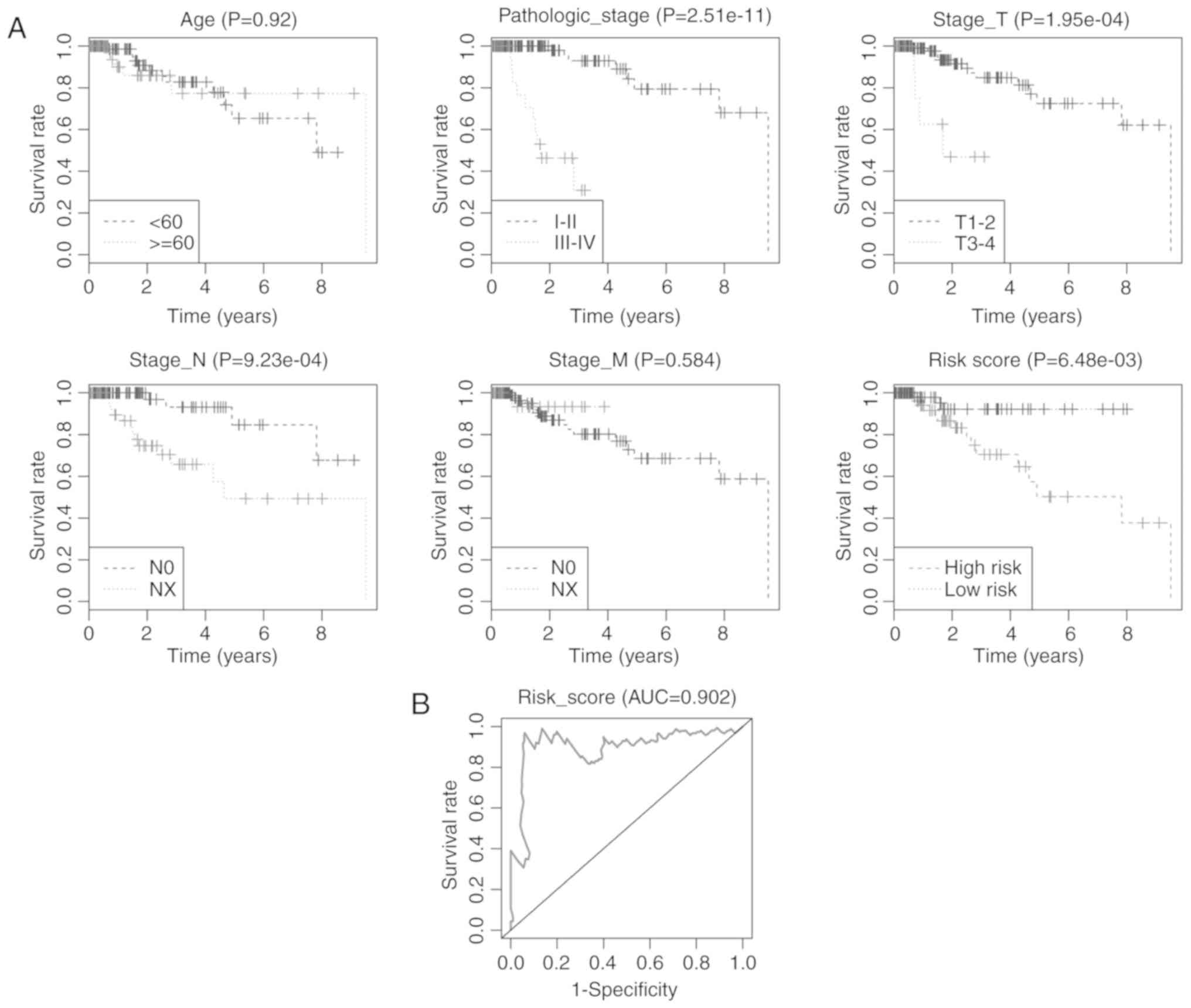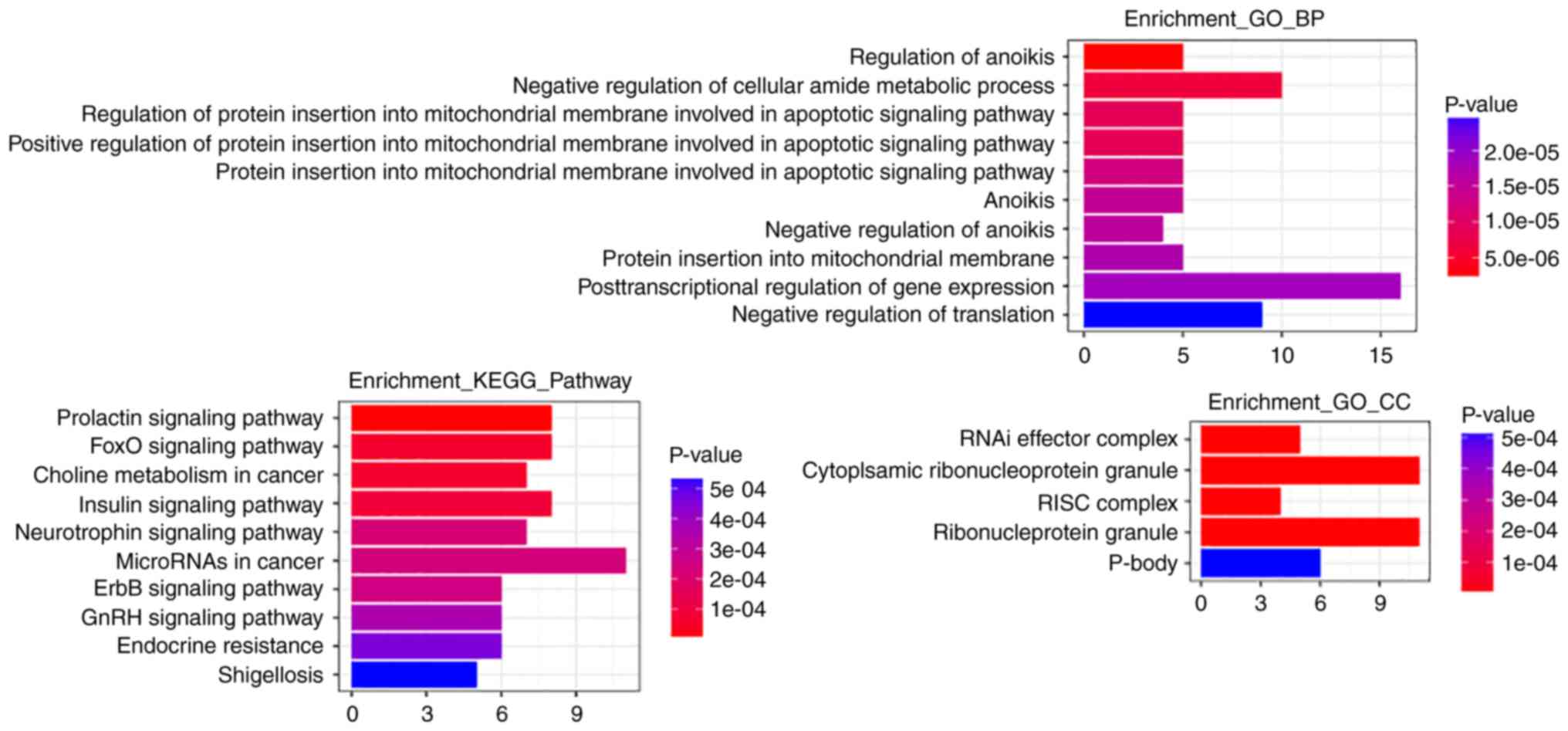Identification of dysregulated microRNAs associated with diagnosis and prognosis in triple‑negative breast cancer: An in silico study
- Authors:
- Published online on: April 2, 2019 https://doi.org/10.3892/or.2019.7094
- Pages: 3313-3324
Abstract
Introduction
Globally, breast cancer remains the leading cause of cancer-related deaths in females. An estimated 1.7 million new cases were diagnosed and 521,900 breast cancer patients succumbed to this disease in 2012 (1). Similarly, in China, a diagnosis of breast cancer between the ages of 30 and 59 years is more common than for any other type of cancer except that of the thyroid (2). Breast cancer is classified into five intrinsic subtypes through detection of progesterone receptor (PR), estrogen receptor-alpha (ERα) and human epidermal growth factor receptor 2 (HER2), namely luminal A-like (ERα+ and/or PR+ and HER2−), luminal B-like (ERα+ and/or PR+ and HER2+), HER2 overexpression (ERα−, PR− and HER2+) and triple-negative breast cancer (TNBC) (HER2−, ERα− and PR−) and normal-like tumors (3). Luminal A-like tumors have higher expression of ER-related genes and lower expression of proliferative genes than luminal B-like cancers (4). Growing evidence indicates that TNBC is a highly aggressive tumor with limited treatment strategies and has poorer survival outcomes compared with other subtypes of breast cancer. Although TNBC patients do benefit from chemotherapy, more effective and less toxic treatments are required in order to reduce the risk of disease progression and improve the prognosis. Therefore, further studies are urgently needed to screen molecular biomarkers to determine the therapeutic efficacy of treatments, and improve the performance of diagnosis and prognosis of TNBC.
MicroRNAs (miRNAs) are small 20–22 nucleotide non-coding RNAs that are known to regulate the expression of genes participating in the control of cell proliferation, apoptosis, development and stress response by binding to the 3′ or 5′ untranslated region of target transcripts (5). Furthermore, miRNAs are also involved in tumorigenesis by acting as either tumor suppressors or oncogenes. This suggests that miRNAs can potentially be biomarkers for cancer diagnosis and prognosis. It has been reported that four miRNAs, namely hsa-miR-125b, hsa-miR-16, hsa-miR-155 and hsa-miR-374a are significantly associated with overall survival of TNBC patients, of which three are correlated with better prognosis and one with worse prognosis (6). In addition, a 4-miRNA signature defined by the expression levels of miR-155, miR-493, miR-30e and miR-27a has both diagnostic and prognostic value for predicting outcomes of TNBC patients most commonly treated with chemotherapy (7). Furthermore, another 4-miRNA signature (miR-18b, miR-103, miR-107 and miR-652) may accurately predict tumor relapse and overall survival of TNBC patients (8). Although several miRNA signatures have been identified which could be used for TNBC diagnosis and survival prediction, the novel prognosis strategy used by miRNA signatures has not been applied in clinical studies. Hence, it is useful to screen new miRNA biomarkers for TNBC overall survival.
In the present study, in order to identify diagnostic and prognostic miRNAs in TNBC patients, we analyzed large scale clinical data and miRNA sequencing data from The Cancer Genome Atlas (TCGA) datasets. After identification of differentially expressed miRNAs in TNBC, miRNAs with diagnostic and prognostic value were identified and a 4-miRNA signature was determined and then used to predict overall survival.
Materials and methods
Retrieval of breast cancer clinical and miRNA expression data
A total of 1,098 anonymized patients were identified in the TCGA database as having breast cancer. The clinical data were retrieved from the TCGA data portal (https://tcga-data.nci.nih.gov/tcga/version 10.0, release time: December 21, 2017; Species: human) on January 22, 2018. Of these 1,098 patients, 155 were diagnosed as having TNBC based on their ER, PR and Her-2 status and defined using immunohistochemistry (IHC). Three patients who were diagnosed as TNBC did not have miRNA expression data recorded and thus were excluded. The other 943 patients were diagnosed as non-triple-negative breast cancer (nTNBC) subtypes (positive expression of ER, PR or Her-2). Finally, a total of 152 TNBC and 943 nTNBC patients were included in the present study. The detailed clinic data is presented in Table I. The follow-up time was different for every patient and the longest time was 3,472 days.
In addition, 1,207 miRNA sequencing datasets from frozen tumor samples by Illumina HiSeq 2000 platform (Illumina, Inc., San Diego, CA, USA) were also downloaded from the TCGA data portal. Of these, 1,103 were tumor samples and 104 were associated with adjacent normal tissue. A total of 200 had unknown ER, PR or Her-2 status and were thus excluded. In total, the miRNA sequencing data from 152 TNBC and 751 nTNBC samples were used for dysregulated miRNA exploration.
Identification of dysregulated miRNAs from TNBC patients
To discover differentially expressed miRNAs from TNBC patients, the edgeR software package of the Bioconductor project (9) using the R programming environment with default parameter settings was utilized. miRNAs from TNBC samples were considered dysregulated in comparison with adjacent normal samples and nTNBC tissue. Differences were assessed with the Mann-Whitney U test and were significant if |log FC (fold change)|>1 and P<0.05. Furthermore, gplots (version 3.0.1; http://cran.r-project.org/src/contrib/Archive/gplots/) and pheatmap (version 1.0.8; http://CRAN.R-project.org/package=pheatmap) packages were used to study the expression levels and distribution of miRNAs expressed differentially between the TNBC and the normal samples as well as the nTNBC tissue with default parameter settings.
Identification of miRNAs with diagnostic value
To identify differentially dysregulated miRNAs that had capacity for diagnosing TNBC, receiver operating characteristic (ROC) curves were plotted to compute the sensitivity and specificity of each miRNA associated with TNBC diagnosis using the pROC software package (version 1.10.0; http://cran.r-project.org/web/packages/pROC/) with default parameter settings. Sensitivity was defined as the percent of tumor cases with a diagnostic test exceeding a criterion and specificity as the percent of non-tumor cases less than or equal to that criterion with a diagnostic test. Dysregulated miRNAs with an area under curve (AUC) >0.8 were selected and miRNAs common to two comparison groups were considered as having diagnostic value.
Survival analysis
The entire set including 104 normal and 152 TNBC samples were randomly divided into a training set (51 normal and 77 TNBC samples) and a validation set (53 normal and 75 TNBC samples). To evaluate the relationship between the miRNA expression levels and the overall survival in tumor patients, univariate Cox regression analysis was conducted with the aim of identifying potential miRNAs related to TNBC prognosis. miRNAs that were clearly associated with patient survival were included when P<0.05 and then subjected to stepwise multivariate Cox regression analysis to construct a TNBC prognostic signature based on the following formula:
Riskscore=exp1xβ1+exp2xβ2+…+expnxβnwhere n was the number of the prognostic miRNA, β was the regression coefficient and exp was the expression level of that miRNA. After risk score acquisition of each patient, patients in the training set were divided into the high-risk and the low-risk groups using the median score as the central cut-off point. In addition, univariate and multivariate Cox proportional hazards regression analyses were performed to examine the relationship between the risk score of TNBC patients and other clinical features including age (<60 or ≥60), pathologic stage (I–II or III–IV), stage T, stage N and stage M. ROC curves were plotted and AUC values were calculated. Patient survival was evaluated using the Kaplan-Meier method and log-rank tests using R package ‘survival’ (version: 2.42–3; http://CRAN.R-project.org/package=survival) with default parameter settings. A 95% confidence interval (CI) and hazard ratio (HR) were calculated to evaluate the prognostic variables related to TNBC survival.
Target prediction of potential miRNA signatures and functional annotation
To gain more insight into the role of prognostic miRNA signatures in TNBC, miRNA-target prediction programs were used to predict the target genes of the miRNAs, including miRDB (http://www.miRdb.org/index.html), miRTarBase (http://miRtarbase.mbc.nctu.edu.tw/php/index.php) and TargetScan (http://www.targetscan.org/vert_71/). Genes that were commonly identified by the three tools were considered as target mRNAs of a prognostic miRNA signature. To reveal the potential roles of the target genes, clusterProfileR package (version 3.6) in the R environment (10) with default parameter settings was employed to perform Gene Ontology (GO) and Kyoto Encyclopedia of Genes and Genomes (KEGG) enrichment analyses. P<0.05 was set as the cut-off.
Results
Identification of differentially expressed miRNAs in TNBC and nTNBC patients
To identify dysregulated miRNAs in TNBC patients in comparison with adjacent normal tissue and miRNAs in TNBC compared with nTNBC samples, the edgeR package was utilized, with 216 upregulated and 73 downregulated miRNAs based on the cut-off of P<0.05 and |log FC|>1 in TNBC compared with adjacent normal samples. When compared with nTNBC samples, there were 58 upregulated and 38 downregulated miRNAs in tumor samples from TNBC patients. Hierarchical clustering of differentially expressed miRNAs presented clear separation in the expression profiles of TNBC compared with normal samples (Fig. 1A) and nTNBC patients (Fig. 1B). A volcano plot was created to indicate the dysregulated expressed miRNAs (Fig. 1C and D).
Diagnostic value of dysregulated miRNAs
ROC analyses were performed to evaluate the possible diagnostic capacity of each dysregulated miRNA. Differentially expressed miRNAs with an AUC >0.8 were selected as miRNAs likely to be useful as biomarkers in the diagnosis of TNBC. We obtained 27 miRNAs from the comparison between the TNBC and the adjacent normal tissue and 6 miRNAs from the comparison between the TNBC and the nTNBC samples with an AUC >0.8. There were 4 common miRNAs between two comparisons, namely hsa-miR-10a, hsa-miR-18a, hsa-miR-135b and hsa-miR-577 (Fig. 2). The expression levels of these 4 miRNAs in TNBC, adjacent normal samples and nTNBC are presented in Fig. 3. Compared with the adjacent normal breast tissues and nTNBC, the expression of hsa-miR-10a was lower in the TNBC tumors however the expression of the other three miRNAs was higher (|log2FC>1|, P<0.001). The results indicated that these miRNAs were specifically upregulated and downregulated in TNBC and could be used as diagnostic biomarkers for the diagnosis of TNBC.
Identification of miRNAs associated with TNBC prognosis
Kaplan-Meier plots and log-rank tests were used to identify miRNAs related to overall survival of TNBC patients with a cut-off log-rank (LR) P<0.05. A total of 8 miRNAs were associated with overall survival, namely: hsa-miR-147b, hsa-miR-203a, hsa-miR-377, hsa-miR-429, hsa-miR-511, hsa-miR-1247, hsa-miR-3922 and hsa-miR-7706 (Fig. 4A). ROC analysis was then performed to assess the prognostic capacity of the miRNAs to predict survival. The AUCs of the 8 miRNAs are displayed in Fig. 4B, and indicated that 2 miRNAs, hsa-miR-203a and hsa-miR-429, may have prognostic value. The AUCs for the 2 miRNAs predicting 5-year survival were 0.771 and 0.702, respectively.
The predictive capacity of a 4-miRNA signature in TNBC
A univariate Cox's proportional hazards regression model was fitted to the entire set and 5 miRNAs (hsa-miR-148b, hsa-miR-203a, hsa-miR-203b, hsa-miR-3922 and hsa-miR-429) were identified as being associated with overall survival with P (HR) <0.01. A group of miRNAs that could be defined as a signature, namely hsa-miR-148b, hsa-miR-203a, hsa-miR-203b and hsa-miR-3922 was identified after stepwise multivariate Cox's regression model analysis by calculating the prognostic risk score. TNBC patients were divided into a low- or a high-risk group depending on their score relative to that of the median risk score (Fig. 5A). The mortality rate of the high-risk group was 19.74% and that of the low-risk group was 3.95%, the difference being significant (P<0.05; Fig. 5B). The heatmap presented in Fig. 5C demonstrated that the 4-miRNA signature was expressed differently in the low- and the high-risk groups. The expression pattern of the 4-miRNA signature in TNBC and normal samples, and the low- and the high-risk groups are presented in Fig. 6. These 4 miRNAs were significantly upregulated in TNBC patients compared with the normal controls (P<0.001). Similarly, three miRNAs, hsa-miR-148b, hsa-miR-203a and hsa-miR-203b, were expressed at a higher level in the high-risk patients than in samples from the low-risk group (P<0.001). However, the expression of hsa-miR-3922 showed the opposite expression pattern (P<0.001).
The 4-miRNA signature is an independent prognostic factor associated with overall survival
Finally, both univariate and multivariate Cox's proportional hazards regression model analyses were performed to evaluate the prognostic power of the 4-miRNA signature. The univariate Cox's regression model demonstrated that pathological stage, N stage, T stage and Risk score based on the 4-miRNA signature were significantly correlated with overall survival of TNBC patients (P<0.05), while the multivariate Cox's regression model revealed that only the pathological stage and Risk score were independent prognostic factors associated with overall survival (P=0.002 and 0.021, respectively; Table II). Kaplan-Meier curves of the clinical characteristics and risk score are displayed in Fig. 7A. The highest survival rate was found within the low-risk group in comparison with the high-risk group (P=0.0065). The AUC for the 4-miRNA signature predicting 5-year survival of TNBC patients was 0.902 (Fig. 7B). Our results suggest that the 4-miRNA signature may have prognostic value for predicting the overall survival of TNBC patients.
Functional annotation of the target genes of the miRNA signature
After target prediction of the 4 miRNAs (hsa-miR-148b, hsa-miR-203a, hsa-miR-203b and hsa-miR-3922) using miRDB, miRTarBase and TargetScan, GO function and KEGG pathway enrichment analysis of the target genes was performed using the R clusterProfiler software package. Details of target genes of the 4 miRNAs are presented in Table III. According to the results of the GO functional enrichment analysis, regulation of anoikis, negative regulation of cellular amide metabolic process and regulation of protein insertion into mitochondrial membranes involved in apoptotic signaling were the most significantly enriched biological processes. The most clearly enriched cellular components were RNAi effector complex, ribonucleoprotein granule, RNA-induced silencing complex (RISC) and ribonucleoprotein granule. The most significantly enriched signaling pathways determined through KEGG analysis were the prolactin signaling pathway, the FOXO signaling pathway, and the ErbB and Insulin signaling pathways, and miRNAs and choline metabolism in cancer. The results of enrichment analysis are displayed in Fig. 8.
Discussion
Growing evidence indicates that triple-negative breast cancer (TNBC) is a heterogeneous disease comprising several distinct disorders with clearly different clinical behavior and molecular characteristics (11,12). However, no specific and well-defined molecular targets have thus far been defined in TNBCs, and therefore few therapeutic strategies can be utilized as treatments, or are on the development horizon. In the present study, we found 4 miRNAs (hsa-miR-10a, hsa-miR-18a, hsa-miR-135b and hsa-miR-577) with significant value in TNBC diagnosis. We conducted a detailed analysis of a 4-miRNA signature which was comprised of hsa-miR-148b, hsa-miR-203a, hsa-miR-203b and hsa-miR-3922 and exhibited capacity for predicting TNBC overall survival.
In previous studies, hsa-miR-10a belonging to the miR-10 family has been revealed to be dysregulated in several types of cancers (13), such as breast (14), glioblastoma (15), lung cancer (16) and chronic lymphocytic leukemia (17). Another member of the miR-10 family, miR-10b, has been demonstrated to functionally contribute to tumor invasion and metastasis in breast cancer (18). hsa-miR-10a and miR-10b deviate only one nucleotide located at the center of their sequence and the primary hsa-miR-10b transcript may be equivalent to a promoter-associated RNA that could be targeted by miR-10a, suggesting the important role of miR-10a in breast cancer progression (19). Liu et al demonstrated that miR-18a prevented ER-α expression blocking the protective effects of estrogen and promoting the development of hepatocellular carcinoma (20). A previous study revealed that the expression of miR-18a-5p was enhanced in TNBC compared with luminal A (21). Aberrant upregulation of miR-18a could enhance autophagy in TNBC cells via inhibition of the mTOR signaling pathway (22) and decrease Dicer expression as well as increase paclitaxel resistance (23). Moreover, hsa-miR-135b was revealed to be upregulated in TNBC tissue which targeted estrogen receptor 1 (ESR1)-related proteins (24). Notably, miR-135b has been proposed as an oncogene involved in the pathogenesis of TNBC and the differential expression of miR-135b in blood could predict overall survival in follow-up of basal-like TNBC patients (25,26). High expression of its family member, hsa-miR-135a, has been demonstrated to be associated with good prognosis in ER-positive tumors (27). Furthermore, hsa-miR-577 has been revealed to be dysregulated in several cancer types including gastric (28), bladder (29) and breast cancer (30). In addition, miR-577 has been demonstrated to suppress epithelial-mesenchymal transition and metastasis by inhibiting Rab25 expression in breast cancer (31). Our results demonstrated that hsa-miR-10a, hsa-miR-18a, hsa-miR-135b and hsa-miR-577 were significantly differentially expressed in the TNBC group and are potential candidate diagnostic markers of TNBC.
A 4-miRNA signature was identified after univariate and multivariate Cox's proportional hazards regression model analysis that was significantly correlated with the overall survival of TNBC patients. miR-148b, a tumor suppressor, has been reported to be dysregulated in pancreatic (32), non-small cell lung cancer (33) and hepatocellular carcinoma (34) through suppression of cell proliferation and invasion by targeting the AMPKα1 and WNT1/β-catenin pathways. A previous study indicated that downregulation of miR-148b may be a molecular biomarker for the early detection of hepatocellular carcinoma and a prognostic marker (35). Increasing evidence indicates that miR-203 is involved in several cancers, including hepatocellular carcinoma (36), prostate (37), breast (38), gastric and colorectal cancers (39) through control of tumor cell proliferation, migration and invasive potential by interaction with target genes. Notably, dysregulated expression of miR-203 has been revealed to be associated with poorer survival of pancreatic tumors (40) and adenocarcinoma (41). As members of the miR-203 family, hsa-miR-203a and hsa-miR-203b may exert important roles in TNBC. Our results found 4 miRNAs (hsa-miR-148b, hsa-miR-203a, hsa-miR-203b and hsa-miR-3922) which may play a role in TNBC prognosis.
To further explore the molecular mechanisms of the miRNA signature in TNBC, target genes of the miRNAs were predicted and functional annotation of targets was performed. The results of functional annotation of target genes revealed that regulation of anoikis, negative regulation of cellular amide metabolic process and protein insertion into mitochondrial membrane involved in the apoptotic signaling pathway were significant enriched GO terms. Anoikis is defined as apoptosis that is induced by inadequate or inappropriate cellular interaction with the extracellular matrix (42). Recently, more studies have confirmed that the breakdown of anoikis leads to the malignancy of mammary and colon cancers (43). Meanwhile, anoikis-resistance is a hallmark of metastasis (44). Therefore, these miRNAs may be involved in TNBC metastasis. According to pathway enrichment analysis of the miRNA signature targets, miRNAs in cancer, and the ErbB and prolactin signaling pathways were clearly enriched terms that encompassed most genes. Increasing evidence suggests that miRNAs participate in almost all aspects of cancer, including proliferation, apoptosis, angiogenesis and invasion/metastasis (45). Therefore, identification of clear diagnostic and prognostic miRNA biomarkers can contribute to cancer evaluation and treatment. Additionally, dimerization of ErbB receptors leads to induction of kinase activity that activates downstream MAPK and PI3K/AKT pathways which have significant involvement in tumor cell proliferation and survival (46). Notably, ErbB-2 overexpression has adverse prognostic value in breast cancer and thus, ErbB-directed strategies have been developed and used as treatments (47). The peptide hormone prolactin, synthesized by human breast cancer cells in culture, has been found to stimulate cell proliferation in an autocrine manner (48). Given the ability of prolactin to stimulate the proliferation of human breast cancer cells and the aberrant expression of its active receptors in breast carcinomas, it is fully consistent that prolactin plays a key role in breast cancer. Consequently, miRNAs in cancer, and the ErbB and prolactin signaling pathways may be significantly implicated in TNBC and inhibition of these pathways may be potential therapeutic strategies for TNBC patients.
However, there is also one limitation in the present study. The percentage of TNBC patients in breast cancer is so small that it is difficult to collect enough TNBC samples with follow-up information in a short time to verify the function of the identified miRNAs. Information of TNBC patients is now collected, however, just a few cases were obtained. The biological roles of these miRNAs in TNBC are still not clear and will be investigated in further experimental studies when enough TNBC samples are obtained.
In conclusion, the present study identified 4 aberrantly expressed miRNAs including hsa-miR-10a, hsa-miR-18a, hsa-miR-135b and hsa-miR-577 with diagnostic value for early diagnosis of TNBC patients, and subsequently, a 4-miRNA signature composed of hsa-miR-148b, hsa-miR-203a, hsa-miR-203b and hsa-miR-3922 was identified that may be a prognostic biomarker for predicting the overall survival of TNBC patients. However, further studies are required to validate these findings and the underlying molecular mechanisms of these miRNAs also require exploitation in combating TNBC in future.
Acknowledgements
We wish to express our warm thanks to Dr Lei Ma (Department of Breast Surgery, China-Japan Union Hospital of Jilin University, Changchun, China) who provided valuable guidance to our research.
Funding
No funding was received.
Availability of data and materials
All raw miRNA RNA-seq and clinical data of TNBC can be downloaded from TCGA data portal.
Authors' contributions
NL conceived and designed the study. CF analyzed the data and wrote the manuscript. Both authors read and approved the manuscript and agree to be accountable for all aspects of the research in ensuring that the accuracy or integrity of any part of the work are appropriately investigated and resolved.
Ethics approval and consent to participate
Not applicable.
Patient consent for publication
Not applicable.
Competing interests
The authors declare that they have no competing interests.
Glossary
Abbreviations
Abbreviations:
|
TNBC |
triple-negative breast cancer |
|
ROC |
receiver operating characteristic |
|
TCGA |
The Cancer Genome Atlas |
|
AUC |
area under curve |
|
miRNA |
microRNA |
References
|
Torre LA, Bray F, Siegel RL, Ferlay J, Lortet-Tieulent J and Jemal A: Global cancer statistics, 2012. CA Cancer J Clin. 65:87–108. 2015. View Article : Google Scholar : PubMed/NCBI | |
|
Chen W, Zheng R, Baade PD, Zhang S, Zeng H, Bray F, Jemal A, Yu XQ and He J: Cancer statistics in China, 2015. CA Cancer J Clin. 66:115–132. 2016. View Article : Google Scholar : PubMed/NCBI | |
|
Carey LA, Perou CM, Livasy CA, Dressler LG, Cowan D, Conway K, Karaca G, Troester MA, Tse CK, Edmiston S, et al: Race, breast cancer subtypes, and survival in the Carolina Breast Cancer Study. JAMA. 295:2492–2502. 2006. View Article : Google Scholar : PubMed/NCBI | |
|
Sorlie T, Tibshirani R, Parker J, Hastie T, Marron JS, Nobel A, Deng S, Johnsen H, Pesich R, Geisler S, et al: Repeated observation of breast tumor subtypes in independent gene expression data sets. Proc Natl Acad Sci USA. 100:8418–8423. 2003. View Article : Google Scholar : PubMed/NCBI | |
|
Croce CM and Calin GA: miRNAs, cancer, and stem cell division. Cell. 122:6–7. 2005. View Article : Google Scholar : PubMed/NCBI | |
|
Cascione L, Gasparini P, Lovat F, Carasi S, Pulvirenti A, Ferro A, Alder H, He G, Vecchione A, Croce CM, et al: Integrated microRNA and mRNA signatures associated with survival in triple negative breast cancer. PLoS One. 8:e559102013. View Article : Google Scholar : PubMed/NCBI | |
|
Gasparini P, Cascione L, Fassan M, Lovat F, Guler G, Balci S, Irkkan C, Morrison C, Croce CM, Shapiro CL, et al: microRNA expression profiling identifies a four microRNA signature as a novel diagnostic and prognostic biomarker in triple negative breast cancers. Oncotarget. 5:1174–1184. 2014. View Article : Google Scholar : PubMed/NCBI | |
|
Kleivi Sahlberg K, Bottai G, Naume B, Burwinkel B, Calin GA, Børresen-Dale AL and Santarpia L: A serum microRNA signature predicts tumor relapse and survival in triple-negative breast cancer patients. Clin Cancer Res. 21:1207–1214. 2015. View Article : Google Scholar : PubMed/NCBI | |
|
Robinson MD, McCarthy DJ and Smyth GK: edgeR: A BioconductoR package for differential expression analysis of digital gene expression data. Bioinformatics. 26:139–140. 2010. View Article : Google Scholar : PubMed/NCBI | |
|
Yu G, Wang LG, Han Y and He QY: clusterProfiler: An R package for comparing biological themes among gene clusters. OMICS. 16:284–287. 2012. View Article : Google Scholar : PubMed/NCBI | |
|
Dawson SJ, Provenzano E and Caldas C: Triple negative breast cancers: Clinical and prognostic implications. Eur J Cancer. 45 (Suppl 1):S27–S40. 2009. View Article : Google Scholar | |
|
Santarpia L, Qi Y, Stemke-Hale K, Wang B, Young EJ, Booser DJ, Holmes FA, O'Shaughnessy J, Hellerstedt B, Pippen J, et al: Mutation profiling identifies numerous rare drug targets and distinct mutation patterns in different clinical subtypes of breast cancers. Breast Cancer Res Treat. 134:333–343. 2012. View Article : Google Scholar : PubMed/NCBI | |
|
Zhang L, Huang J, Yang N, Greshock J, Megraw MS, Giannakakis A, Liang S, Naylor TL, Barchetti A, Ward MR, et al: microRNAs exhibit high frequency genomic alterations in human cancer. Proc Natl Acad Sci USA. 103:9136–9141. 2006. View Article : Google Scholar : PubMed/NCBI | |
|
Tan Y, Zhang B, Wu T, Skogerbø G, Zhu X, Guo X, He S and Chen R: Transcriptional inhibiton of Hoxd4 expression by miRNA-10a in human breast cancer cells. BMC Mol Biol. 10:122009. View Article : Google Scholar : PubMed/NCBI | |
|
Yan Y, Wang Q, Yan XL, Zhang Y, Li W, Tang F, Li X and Yang P: miR-10a controls glioma migration and invasion through regulating epithelial-mesenchymal transition via EphA8. FEBS Lett. 589:756–765. 2015. View Article : Google Scholar : PubMed/NCBI | |
|
Markou A, Sourvinou I, Vorkas PA, Yousef GM and Lianidou E: Clinical evaluation of microRNA expression profiling in non small cell lung cancer. Lung Cancer. 81:388–396. 2013. View Article : Google Scholar : PubMed/NCBI | |
|
Gaur A, Jewell DA, Liang Y, Ridzon D, Moore JH, Chen C, Ambros VR and Israel MA: Characterization of microRNA expression levels and their biological correlates in human cancer cell lines. Cancer Res. 67:2456–2468. 2007. View Article : Google Scholar : PubMed/NCBI | |
|
Ma L: Role of miR-10b in breast cancer metastasis. Breast Cancer Res. 12:2102010. View Article : Google Scholar : PubMed/NCBI | |
|
Han J, Kim D and Morris KV: Promoter-associated RNA is required for RNA-directed transcriptional gene silencing in human cells. Proc Natl Acad Sci USA. 104:12422–12427. 2007. View Article : Google Scholar : PubMed/NCBI | |
|
Liu WH, Yeh SH, Lu CC, Yu SL, Chen HY, Lin CY, Chen DS and Chen PJ: MicroRNA-18a prevents estrogen receptor-alpha expression, promoting proliferation of hepatocellular carcinoma cells. Gastroenterology. 136:683–693. 2009. View Article : Google Scholar : PubMed/NCBI | |
|
Calvano Filho CM, Calvano-Mendes DC, Carvalho KC, Maciel GA, Ricci MD, Torres AP, Filassi JR and Baracat EC: Triple-negative and luminal A breast tumors: Differential expression of miR-18a-5p, miR-17-5p, and miR-20a-5p. Tumour Biol. 35:7733–7741. 2014. View Article : Google Scholar : PubMed/NCBI | |
|
Fan YX, Dai YZ, Wang XL, Ren YQ, Han JJ and Zhang H: MiR-18a upregulation enhances autophagy in triple negative cancer cells via inhibiting mTOR signaling pathway. Eur Rev Med Pharmacol Sci. 20:2194–2200. 2016.PubMed/NCBI | |
|
Sha LY, Zhang Y, Wang W, Sui X, Liu SK, Wang T and Zhang H: MiR-18a upregulation decreases dicer expression and confers paclitaxel resistance in triple negative breast cancer. Eur Rev Med Pharmacol Sci. 20:2201–2208. 2016.PubMed/NCBI | |
|
Dai X, Chen A and Bai Z: Integrative investigation on breast cancer in ER, PR and HER2-defined subgroups using mRNA and miRNA expression profiling. Sci Rep. 4:65662014. View Article : Google Scholar : PubMed/NCBI | |
|
Uva P, Cossu-Rocca P, Loi F, Pira G, Murgia L, Orrù S, Floris M, Muroni MR, Sanges F, Carru C, et al: miRNA-135b contributes to triple negative breast cancer molecular heterogeneity: Different expression profile in basal-like versus non-basal-like phenotypes. Int J Med Sci. 15:536–548. 2018. View Article : Google Scholar : PubMed/NCBI | |
|
Paszek S, Gablo N, Barnas E, Szybka M, Morawiec J, Kołacińska A and Zawlik I: Dysregulation of microRNAs in triple-negative breast cancer. Ginekol Pol. 88:530–536. 2017. View Article : Google Scholar : PubMed/NCBI | |
|
Buffa FM, Camps C, Winchester L, Snell CE, Gee HE, Sheldon H, Taylor M, Harris AL and Ragoussis J: microRNA-associated progression pathways and potential therapeutic targets identified by integrated mRNA and microRNA expression profiling in breast cancer. Cancer Res. 71:5635–5645. 2011. View Article : Google Scholar : PubMed/NCBI | |
|
Pan HW, Li SC and Tsai KW: MicroRNA dysregulation in gastric cancer. Curr Pharm Des. 19:1273–1284. 2013. View Article : Google Scholar : PubMed/NCBI | |
|
Tatarano S, Chiyomaru T, Kawakami K, Enokida H, Yoshino H, Hidaka H, Yamasaki T, Kawahara K, Nishiyama K, Seki N, et al: miR-218 on the genomic loss region of chromosome 4p15.31 functions as a tumor suppressor in bladder cancer. Int J Oncol. 39:13–21. 2011.PubMed/NCBI | |
|
Kolacinska A, Morawiec J, Fendler W, Malachowska B, Morawiec Z, Szemraj J, Pawlowska Z, Chowdhury D, Choi YE, Kubiak R, et al: Association of microRNAs and pathologic response to preoperative chemotherapy in triple negative breast cancer: Preliminary report. Mol Biol Rep. 41:2851–2857. 2014. View Article : Google Scholar : PubMed/NCBI | |
|
Yin C, Mou Q, Pan X, Zhang G, Li H and Sun Y: MiR-577 suppresses epithelial-mesenchymal transition and metastasis of breast cancer by targeting Rab25. Thorac Cancer. 9:472–479. 2018. View Article : Google Scholar : PubMed/NCBI | |
|
Zhao G, Zhang JG, Liu Y, Qin Q, Wang B, Tian K, Liu L, Li X, Niu Y, Deng SC, et al: miR-148b functions as a tumor suppressor in pancreatic cancer by targeting AMPKalpha1. Mol Cancer Ther. 12:83–93. 2013. View Article : Google Scholar : PubMed/NCBI | |
|
Yang JS, Li BJ, Lu HW, Chen Y, Lu C, Zhu RX, Liu SH, Yi QT, Li J and Song CH: Serum miR-152, miR-148a, miR-148b, and miR-21 as novel biomarkers in non-small cell lung cancer screening. Tumour Biol. 36:3035–3042. 2015. View Article : Google Scholar : PubMed/NCBI | |
|
Zhang JG, Shi Y, Hong DF, Song M, Huang D, Wang CY and Zhao G: MiR-148b suppresses cell proliferation and invasion in hepatocellular carcinoma by targeting WNT1/β-catenin pathway. Sci Rep. 5:80872015. View Article : Google Scholar : PubMed/NCBI | |
|
Ziari K, Zarea M, Gity M, Fayyaz AF, Yahaghi E, Darian EK and Hashemian AM: Downregulation of miR-148b as biomarker for early detection of hepatocellular carcinoma and may serve as a prognostic marker. Tumour Biol. 37:5765–5768. 2016. View Article : Google Scholar : PubMed/NCBI | |
|
Furuta M, Kozaki KI, Tanaka S, Arii S, Imoto I and Inazawa J: miR-124 and miR-203 are epigenetically silenced tumor-suppressive microRNAs in hepatocellular carcinoma. Carcinogenesis. 31:766–776. 2010. View Article : Google Scholar : PubMed/NCBI | |
|
Saini S, Majid S, Yamamura S, Tabatabai L, Suh SO, Shahryari V, Chen Y, Deng G, Tanaka Y and Dahiya R: Regulatory role of mir-203 in prostate cancer progression and metastasis. Clin Cancer Res. 17:5287–5298. 2011. View Article : Google Scholar : PubMed/NCBI | |
|
Zhang Z, Zhang B, Li W, Fu L, Fu L, Zhu Z and Dong JT: Epigenetic silencing of miR-203 upregulates SNAI2 and contributes to the invasiveness of malignant breast cancer cells. Genes Cancer. 2:782–791. 2011. View Article : Google Scholar : PubMed/NCBI | |
|
Chiang Y, Song Y, Wang Z, Chen Y, Yue Z, Xu H, Xing C and Liu Z: Aberrant expression of miR-203 and its clinical significance in gastric and colorectal cancers. J Gastrointest Surg. 15:63–70. 2011. View Article : Google Scholar : PubMed/NCBI | |
|
Greither T, Grochola LF, Udelnow A, Lautenschlager C, Wurl P and Taubert H: Elevated expression of microRNAs 155, 203, 210 and 222 in pancreatic tumors is associated with poorer survival. Int J Cancer. 126:73–80. 2010. View Article : Google Scholar : PubMed/NCBI | |
|
Hezova R, Kovarikova A, Srovnal J, Zemanova M, Harustiak T, Ehrmann J, Hajduch M, Svoboda M, Sachlova M and Slaby O: Diagnostic and prognostic potential of miR-21, miR-29c, miR-148 and miR-203 in adenocarcinoma and squamous cell carcinoma of esophagus. Diagn Pathol. 10:422015. View Article : Google Scholar : PubMed/NCBI | |
|
Frisch SM and Francis H: Disruption of epithelial cell-matrix interactions induces apoptosis. J Cell Biol. 124:619–626. 1994. View Article : Google Scholar : PubMed/NCBI | |
|
Streuli CH and Gilmore AP: Adhesion-mediated signaling in the regulation of mammary epithelial cell survival. J Mammary Gland Biol Neoplasia. 4:183–191. 1999. View Article : Google Scholar : PubMed/NCBI | |
|
Park SH, Riley P IV and Frisch SM: Regulation of anoikis by deleted in breast cancer-1 (DBC1) through NF-κB. Apoptosis. 18:949–962. 2013. View Article : Google Scholar : PubMed/NCBI | |
|
Garofalo M, Leva GD and Croce CM: MicroRNAs as anti-cancer therapy. Curr Pharm Des. 20:5328–5335. 2014. View Article : Google Scholar : PubMed/NCBI | |
|
Yarden Y and Sliwkowski MX: Untangling the ErbB signalling network. Nat Rev Mol Cell Biol. 2:127–137. 2001. View Article : Google Scholar : PubMed/NCBI | |
|
DiGiovanna MP, Stern DF, Edgerton SM, Whalen SG, Moore D II and Thor AD: Relationship of epidermal growth factor receptor expression to ErbB-2 signaling activity and prognosis in breast cancer patients. J Clin Oncol. 23:1152–1160. 2005. View Article : Google Scholar : PubMed/NCBI | |
|
Vonderhaar BK: Prolactin involvement in breast cancer. Endocr Relat Cancer. 6:389–404. 1999. View Article : Google Scholar : PubMed/NCBI |



